 W
WThe Hudson's Bay Company is a Canadian, now American-owned, retail business group. A fur trading business for much of its existence, HBC now owns and operates retail stores in Canada and the United States. It had been a member of the International Association of Department Stores from 2001 to 2005.
 W
WThe Arcadian Court is an Art Deco event space in Toronto, Ontario, Canada. It is located on the eighth floor of the flagship downtown Toronto location of the Canadian department store The Bay at Yonge and Queen Streets. For many years, it was an exclusive restaurant, then an art gallery, then closed and used for storage. It was restored and is now used as an event space.
 W
WThe Athabasca Landing Trail was a long-distance portage route that linked Fort Edmonton on the North Saskatchewan River with Athabasca Landing on the Athabasca River. The distance of the trail between Fort Edmonton and Athabasca Landing was 100 miles (160 km), giving the trail the nickname "The 100 Mile Portage."
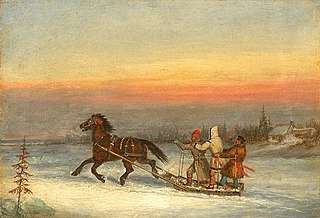 W
WA capote or capot is a long coat with a hood.
 W
WThe Capture of York Factory was a 1694 Anglo-French conflict on Hudson Bay. In 1686 Pierre Le Moyne d'Iberville marched overland from Québec and captured all the English posts on James Bay. This left York Factory, which was too far away and could only be reached by sea. In 1688 King William's War started and the needed ships were hard to get. In 1690 Iberville tried to take York Factory but was driven away by a larger English ship. In 1694 Governor Frontenac gave him the ships Salamandre and Poli. Iberville reached the Nelson River on 14 September. The fort was invested and on 14 October it surrendered..
 W
WThe Columbia District was a fur trading district in the Pacific Northwest region of British North America in the 19th century. Much of its territory overlapped with the disputed Oregon Country. It was explored by the North West Company between 1793 and 1811, and established as an operating fur district around 1810. The North West Company was absorbed into the Hudson's Bay Company in 1821 under which the Columbia District became known as the Columbia Department. The Oregon Treaty of 1846 marked the effective end of the Hudson's Bay Company's Columbia Department.
 W
WSS Colvile was a Lake Winnipeg steamboat built for the Hudson's Bay Company in Grand Forks, Dakota Territory. Colvile was constructed, using some parts of the vessel called Chief Commissioner which in turn used a boiler taken from Anson Northup. Colvile was one of the largest vessels constructed for the HBC. The company hired Captain J. Reeves to supervise the construction of the vessel.
 W
WA coonskin cap is a hat fashioned from the skin and fur of a raccoon. The original coonskin cap consisted of the entire skin of the raccoon including its head and tail. Beginning as traditional Native American headgear, coonskin caps became associated with American frontiersmen of the 18th and 19th centuries, and were highly popular among boys in the United States, Canada, the United Kingdom and Australia in the 1950s.
 W
WThe Deed of Surrender or Rupert's Land and North-Western Territory Order is an 1870 British order in council that transferred ownership of Rupert's Land and the North-Western Territory from the Hudson's Bay Company (HBC) to the newly created Dominion of Canada. The Deed ended just over 200 years of HBC control over the lands and began western Canadian expansion. While the Deed of Surrender was actually only a schedule in the order, the name "Deed of Surrender" is generally understood to refer to the document as a whole. Often confused with Rupert's Land Act 1868, the Deed is different as the Act only expressed that the United Kingdom and Canada permitted the transfer, but did not settle on the details of exchange with HBC, which were outlined in the Deed of Surrender.
 W
WFactory was the common name during the medieval and early modern eras for an entrepôt – which was essentially an early form of free-trade zone or transshipment point. At a factory, local inhabitants could interact with foreign merchants, often known as factors. First established in Europe, factories eventually spread to many other parts of the world.
 W
WThe 1688 Battle of Fort Albany was one of the Anglo-French conflicts on Hudson Bay. In the Hudson Bay expedition (1686) the French had, in time of peace, marched overland from Quebec and captured all three English posts on James Bay. The French had left a garrison at Fort Albany, Ontario and needed to send a ship to resupply it and take out the furs. The Hudson's Bay Company learned of its loss in January 1687 and appealed to the king. This led to about a year of diplomatic negotiations. In 1688 the Company sent five ships to the Bay. Two went to its remaining post at York Factory, one went to reestablish Rupert House which the French had burned and two went to Fort Albany on the west shore of James Bay. Their instructions were to re-establish the English trade and not to use force against the French unless the French did so first.
 W
WThe Battle of Fort Albany was an attack by French colonial volunteers and their native allies against the Canadian Hudson's Bay Company outpost of Fort Albany in the southern reaches of Hudson Bay. About 70 Frenchmen and 30 Indians attacked the fort, which was under the command of John Fullartine. Fullartine repulsed the attack, killing eighteen men including the leaders. He lost two men to ambush on their way back to the fort shortly after the attack.
 W
WFreiman Mall is an enclosed arcade between Rideau and George Streets in Ottawa, Ontario, Canada, east of Sussex Drive and west of William Street. The adjacent Hudson's Bay department store abuts the Freiman Mall on both its north and south sides, and can be accessed from the Freiman Mall interior in downtown Ottawa.
 W
WA.J. Freiman Limited, or Freimans, was a landmark department store at 73 Rideau Street in Ottawa, Ontario, Canada, founded in 1918 by Archibald J. Freiman.
 W
WHome Outfitters was a Canadian retail home decor chain, owned by Hudson's Bay Company, that sold bedding, towels, housewares, and other home accessories. It ceased operations in July 2019, when it closed all 37 remaining stores.
 W
WThe Hudson Bay expedition was a series of military raids on the fur trading outposts and fortifications of the British Hudson's Bay Company on the shores of Hudson Bay by a French Royal Navy squadron under the command of the Comte de Lapérouse. Setting sail from Cap-Français, Saint-Domingue in 1782, the expedition was part of a series of globe-spanning naval conflicts between France and Great Britain during the American Revolutionary War.
 W
WThe Hudson Bay expedition of 1686 was one of the Anglo-French conflicts on Hudson Bay. It was the first of several expeditions sent from New France against the trading outposts of the Hudson's Bay Company in the southern reaches of Hudson Bay. Led by the Chevalier de Troyes, the expedition captured the outposts at Moose Factory, Rupert House, Fort Albany, and the company ship Craven.
 W
WHudson's Bay, colloquially known online as The Bay, is a Canadian luxury goods department store chain. It is the flagship brand of the Hudson's Bay Company (HBC), the oldest and longest-surviving company in North America.
 W
WHudson's Bay Centre is an office and retail complex in Toronto, Ontario, Canada. It is located in Downtown Toronto at the intersection of Yonge Street and Bloor Street at the east end of the Mink Mile. Brookfield Properties owns and operates the centre. The centre is composed of a 35-storey office tower, a Hudson's Bay department store and a retail concourse.
 W
WThe flag of the Hudson's Bay Company is used to represent the Hudson's Bay Company. The flag varied over time. From July 21, 1682 to 1965, the flag consists of the Red Ensign with the letters "HBC" in the lower field. In 1970 the company used the flag that display the company's coat of arms. Currently the company flag is the banner form of the company logo.
 W
WHudson's Bay Montreal Downtown is a building complex on the corner of Saint Catherine Street West and Union Avenue in downtown Montreal, Quebec, Canada. It was originally named the Henry Morgan Building, and operated as the flagship store of the Morgan's department store chain from 1891–1972. It became the provincial flagship store of its successor, The Bay, in 1972.
 W
WHudson's Bay Oil and Gas Company Limited was a Canadian non-integrated petroleum company that operated between 1926 and 1982. Originally called the Hudson's Bay Marland Oil Company (HBMOC), it was founded as a joint venture between the Hudson's Bay Company and the Marland Oil Company with the purpose of producing oil on land where the HBC held mineral rights. In 1929 the Continental Oil Company (Conoco) purchased Marland Oil and reformed the HBMOC as the Hudson's Bay Oil and Gas Company (HBOG). By the 1960s HBOG had become the third largest oil producer in Canada. Between 1981 and 1982, Dome Petroleum, also based in Calgary, acquired HBOG for $4 billion in what was then the most expensive takeover in Canadian history. The purchase by Dome ultimately contributed to its own demise in 1988, at which time it was acquired by Amoco Canada. The assets of HBOG, Dome, and Amoco have since 1998 belonged to BP Canada.
 W
WA Hudson's Bay point blanket is a type of wool blanket traded by the Hudson's Bay Company (HBC) in British North America, now Canada and the United States from 1779 to present. The blankets were typically traded to First Nations in exchange for beaver pelts. The blankets continue to be sold by Canada's Hudson's Bay department stores and have come to hold iconic status in the country.
 W
WHudson's Bay Queen Street is a building complex on the southwest corner of Yonge Street and Queen Street West in downtown Toronto, Ontario, Canada. It was originally named the Simpson's Department Store, and operated as the flagship store of the Simpsons department store chain from 1895–1991. It became a flagship store of its successor, The Bay, in 1991. The building was retrofitted to house the first Saks Fifth Avenue department store in Canada in 2016.
 W
WThe Hudson's Bay Company's flagship Vancouver Downtown store is a six-storey building in downtown Vancouver. Located at 674 Granville Street, on the corner of Georgia Street, the cream terra cotta building with Corinthian columns was built in 1927. The current store was built on the site of another HBC store from 1893. The last additions were made in 1949.
 W
WThe Hudson's Bay Company began a trading post in Yellowknife, Northwest Territories, Canada in 1938 at the height of the first gold rush in the region. Fire destroyed the original building in January 1945, and the HBC rebuilt and reopened this expanded trading post store and warehouse in November 1945. It served the Old Town waterfront of Yellowknife for several years. The post was primarily designed for prospector's bush orders during the gold boom years. With the opening of a modern downtown department store in 1947, the Old Town post catered almost exclusively to bush orders, fur trappers, commercial fishers, and prospector supplies. The store closed in 1960 when all HBC operations were centralized to the downtown location. Thereafter, the building was used only as a warehouse for HBC retail operations. The Bay retail stores were rebranded as Northern Stores Inc in 1987 and the warehouse was sold to Les Rocher who has owned it ever since.
 W
WKanaka Creek is an historic rural residential area located within the District of Maple Ridge, British Columbia, Canada, along the banks of the creek of the same name just east of the district's main town and commercial core of Haney. Just east is Albion and immediately across the Fraser River is Derby or "Old Fort Langley", upstream from which and opposite Albion is Fort Langley. Kanaka Creek was settled by Hawaiian natives in the employ of the Hudson's Bay Company, known as Kanakas, often with local indigenous, usually Kwantlen, wives. Once a thriving community linked closely to the affairs of the fort, like the rancherie outside Fort Vancouver, Kanaka Creek dwindled somewhat when the fort was located further upstream, although some of the original families stayed on for decades. The area has long since been subdivided and is a suburban neighbourhood now, with Kanaka Creek Road, along the creek's west bank, the main arterial, which like the creek runs generally northeast, finally becoming 232nd Street to connect to the Dewdney Trunk Road. Upstream, to the northeast, is Kanaka Creek Regional Park and street connections to Webster's Corners and 240th Street. Although mostly suburban the neighbourhood retains a greenbelt quality because of the protection of the creek by its park and as a salmon spawning stream, and there are still farms operating in some parts of the area.
 W
WLord & Taylor was a American department store chain, which has now become an e-commerce retailer. It was America's oldest department store, staying in business from 1826 to 2021. At the time of its closure, the company maintained 38 stores and one outlet store. The flagship store at the Lord & Taylor Building on Fifth Avenue in New York City operated from 1914 until 2019.
 W
WThe maritime fur trade was a ship-based fur trade system that focused on acquiring furs of sea otters and other animals from the indigenous peoples of the Pacific Northwest Coast and natives of Alaska. The furs were mostly sold in China in exchange for tea, silks, porcelain, and other Chinese goods, which were then sold in Europe and the United States. The maritime fur trade was pioneered by Russians, working east from Kamchatka along the Aleutian Islands to the southern coast of Alaska. British and Americans entered during the 1780s, focusing on what is now the coast of British Columbia. The trade boomed around the beginning of the 19th century. A long period of decline began in the 1810s. As the sea otter population was depleted, the maritime fur trade diversified and transformed, tapping new markets and commodities, while continuing to focus on the Northwest Coast and China. It lasted until the middle to late 19th century.
 W
WHenry Morgan & Company was a Canadian department store chain founded by Henry Morgan in 1845. The first store was located in Montreal, and expanded to include 11 stores in Ontario and Quebec before being bought by Hudson's Bay Company in 1960. The stores in Ontario were converted to Hudson's Bay Company stores that year and renamed The Bay in 1965; the remaining Morgan's stores in Quebec were renamed La Baie in 1972.
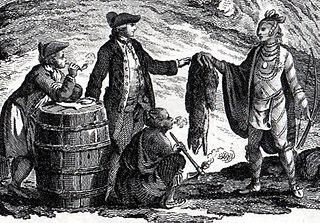 W
WThe North American fur trade refers to the commercial trade in furs in North America. Various indigenous people of the Americas traded furs with other tribes during the pre-Columbian era. Europeans started their participation in the North American fur trade from the initial period of their colonization of the Americas onward, extending the trade's reach to Europe. European merchants from France, England and the Dutch Republic established trading posts and forts in various regions of North America to conduct the trade with local indigenous tribes. The trade reached the peak of its economic importance in the 19th century, by which time it relied upon elaborately developed trade networks.
 W
WThe North-Western Territory was a region of British North America extant until 1870 and named for where it lay in relation to Rupert's Land.
 W
WNRDC Equity Partners is an American private investment firm focused on retail, real estate, and consumer branded businesses.
 W
WIn January 1814 Governor Miles MacDonell, appointed by Thomas Douglas, 5th Earl of Selkirk issued to the inhabitants of the Red River area a proclamation which became known as the Pemmican Proclamation. The proclamation was issued in attempt to stop the Métis people from exporting pemmican out of the Red River district. Cuthbert Grant, leader of the Métis, disregarded MacDonell's proclamation and continued the exportation of pemmican to the North West Company. The proclamation overall, became one of many areas of conflict between the Métis and the Red River settlers. Thomas Douglas, 5th Earl of Selkirk had sought interest in the Red River District, with the help of the Hudson's Bay Company as early as 1807. However, it was not until 1810 that the Hudson's Bay Company asked Lord Selkirk for his plans on settling in the interior of Canada.
 W
WThe Pemmican War was a series of armed confrontations during the North American fur trade between the Hudson's Bay Company (HBC) and the North West Company (NWC) in the years following the establishment of the Red River Colony in 1812 by Lord Selkirk. It ended in 1821 when the NWC merged with the HBC.
 W
WThe Portage La Loche Brigade was a York boat fur brigade that travelled between Fort Garry, the Methye Portage and York Factory in Rupert's Land. This famous brigade travelled 4000 miles every year and was part of the Hudson's Bay Company transportation system during the North American fur trade. Their trip from Fort Garry to Portage La Loche would begin around 1 June and end around 8 October. Only one other brigade had a longer route. The York Factory Express brigade travelled 4200 miles from York Factory to Fort Vancouver until 1846.
 W
WThe Red River Colony was a colonization project set up in 1811 by Thomas Douglas, 5th Earl of Selkirk, on 300,000 square kilometres (120,000 sq mi) of land. This land was granted to Douglas by the Hudson's Bay Company in the Selkirk Concession. It included portions of Rupert's Land, or the watershed of Hudson Bay, bounded on the north by the line of 52° N latitude roughly from the Assiniboine River east to Lake Winnipegosis. It then formed a line of 52° 30′ N latitude from Lake Winnipegosis to Lake Winnipeg, and by the Winnipeg River, Lake of the Woods and Rainy River.
 W
WRevillon Frères was a French fur and luxury goods company, founded in Paris in 1723. Then called la Maison Givelet, it was purchased by Louis-Victor Revillon in 1839 and soon, as Revillon Frères, became the largest fur company in France. Branches were opened in London in 1869 and in New York in 1878. At the end of the 19th century, Revillon had stores in Paris, London, New York City, and Montreal.
 W
WRupert's Land, or Prince Rupert's Land, was a territory in British North America comprising the Hudson Bay drainage basin, a territory in which a commercial monopoly was operated by the Hudson's Bay Company for 200 years from 1670 to 1870. It was named after Prince Rupert of the Rhine, a nephew of Charles I and the first Governor of the Hudson's Bay Company (HBC). In December 1821, the HBC monopoly was extended from Rupert's Land to the Pacific coast.
 W
WThe Rupert's Land Act 1868 was an Act of the Parliament of the United Kingdom of Great Britain and Ireland, authorizing the transfer of Rupert's Land from the control of the Hudson's Bay Company to the Dominion of Canada. Often confused with the Deed of Surrender, the Act is different as it only expressed that the United Kingdom and Canada permitted the transfer but did not settle on the details of exchange with HBC which were then outlined in the Deed.
 W
WSaks Off 5th, formerly Saks Fifth Avenue Off 5th, is an American off-price department store chain founded in 1990, and a subsidiary of the luxury department store chain Saks Fifth Avenue. Since 2013, both Saks Off 5th and Saks Fifth Avenue have been owned by the Hudson's Bay Company (HBC), along with HBC's namesake Canadian department stores. It is comparable to other off-price stores including Nordstrom Rack, and traditional department stores.
 W
WSaks, Inc., originally Proffitt's Inc. until 1998, was a Fortune 1000 operator of high-end department stores in the United States under the nameplate Saks Fifth Avenue. It was founded in Birmingham, Alabama. Hudson's Bay Company acquired Saks in November 2013.
 W
WThe Battle of Seven Oaks was a violent confrontation in the Pemmican War between the Hudson's Bay Company (HBC) and the North West Company (NWC), rivals in the fur trade, that took place on 19 June 1816, the climax of a long dispute in western Canada. The Métis people fought for the North West Company, and they called it "the Victory of Frog Plain".
 W
WThe Simpson Tower, located at 401 Bay Street, is the 38th-tallest building in Toronto, Ontario, Canada. Completed in 1968 by architect John B. Parkin, as the headquarters of the Simpsons department store company, it has 33 floors and is 144 m (472 ft) high. In 1978, as part of a corporate takeover, the Simpson Tower became the property of the Hudson's Bay Company. The building today remains the head office of HBC and also houses the head office of subsidiaries Hudson's Bay and Home Outfitters. It is adjacent to the historic Simpsons store at Yonge and Queen, which includes Arcadian Court. Today the store is the flagship for Hudson's Bay, is integrated with the Eaton Centre across Queen Street, and is the home of Toronto's comprehensive health centre.
 W
WThe Robert Simpson Company Limited, commonly known as Simpson's until 1972, then as Simpsons, and in Quebec sometimes as Simpson, was a Canadian department store chain that had its earliest roots in a store opened in 1858 by Robert Simpson.
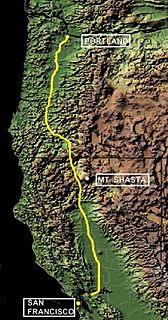 W
WThe Siskiyou Trail stretched from California's Central Valley to Oregon's Willamette Valley; modern-day Interstate 5 follows this pioneer path. Originally based on existing Native American foot trails winding their way through river valleys, the Siskiyou Trail provided the shortest practical travel path between early settlements in California and Oregon.
 W
WThe Stickeen Territories, also colloquially rendered as Stickeen Territory, Stikine Territory, and Stikeen Territory, was a territory of British North America whose brief existence began July 19, 1862, and concluded July of the following year. The region was split from the North-Western Territory in the wake of the Stikine Gold Rush. The initial strike attracted large numbers of miners — mostly American — to the region; by detaching the region from the exclusive trade zone of the Hudson's Bay Company, British authorities were able to impose tariffs and licences on the speculators. The new territory, named after the Stikine River, was under the responsibility of the Governor of the Colony of British Columbia, James Douglas, who was appointed "Administrator of the Stickeen Territories" and under British law, within the jurisdiction of the Supreme Court of British Columbia.
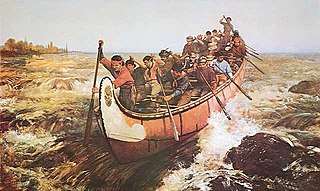 W
WThe voyageurs were 18th and 19th century French Canadians who engaged in the transporting of furs via canoe during the peak of the North American fur trade. The emblematic meaning of the term applies to places and times where transportation of materials was mainly over long distances. The voyageurs were regarded as legendary. They were heroes celebrated in folklore and music. For reasons of promised celebrity status and wealth, this position was coveted.
 W
WWoodward's Stores Ltd. was a department store chain that operated in Alberta and British Columbia, Canada, for one hundred years, before its sale to the Hudson's Bay Company.
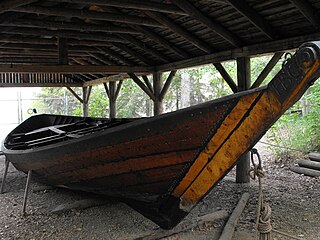 W
WThe York boat was a type of inland boat used by the Hudson's Bay Company to carry furs and trade goods along inland waterways in Rupert's Land, the watershed stretching from Hudson Bay to the eastern slopes of the Rocky Mountains. It was named after York Factory, the headquarters of the HBC, and modeled after the Orkney yole. Two variations to the York Boat were scows and "Sturgeon Heads."
 W
WThe York Factory Express, usually called "the Express" and also the Columbia Express and the Communication, was a 19th-century fur brigade operated by the Hudson's Bay Company (HBC). Roughly 4,200 kilometres (2,600 mi) in length, it was the main overland connection between HBC headquarters at York Factory and the principal depot of the Columbia Department, Fort Vancouver.
 W
WZellers was a Canadian discount department retail chain and currently a brand name owned by the Hudson's Bay Company (HBC). Founded in 1931, it was based in Brampton, Ontario. Zellers was acquired by HBC in 1978 before closing in 2013.